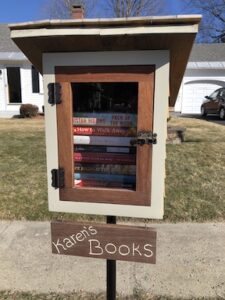There are Little Free Libraries and then there are the Big Free Libraries. In the first, you give and take books found in public boxes along roadsides. Our village of Shelburne Falls has eight at last count. With Big Free Libraries, the concept is that you borrow a book, in whatever form, and return it within a certain amount of time so others can do the same. Basically, these libraries act like warehouses but, oh, so many of them are beautiful buildings, often donated by someone who lived there and wanted to give their town a special gift. That’s true about my village.
My love of libraries began as a child when our mother would take us to the Millicent Rogers Library in my hometown of Fairhaven, Massachusetts. She brought us there often, especially during summer vacation when we would load up on books. Besides the books I borrowed — trying to read as many of L. Frank Baum’s 14 Oz books as possible — I marveled at the building’s beauty. I recall when I was old enough to explore the stacks in the adult section.
I loved the library’s history, that Henry Huttleston Rogers, who grew up in our town and became vice-president of the Standard Oil Company, had it built as a memorial to his daughter, Millicent, who sadly died when she was 17. That was in 1893. (Later, when I lived in Taos, New Mexico, I would encounter another Millicent Rogers, Henry’s granddaughter, who has an art museum in her name.) The library, designed by the famous architect Charles Brigham, was built of granite in the Richardsonian Romanesque style. It was one of many buildings Rogers donated, including my magnificent high school.
Doing a little research, I found Benjamin Franklin had a hand in the development of the first lending library. In 1790, he donated a collection of books to the Massachusetts town of Franklin, which named itself after him. Townspeople voted to make those donated books freely available for town members, thus creating the nation’s first public library. Certainly, that idea has spread.
As an adult, wherever I lived, in cities or towns, I sought out the public library. I never found one that didn’t have one. What better way to discover an author and read everything that person wrote, especially since through interlibrary loan, I could get almost any book.
Some of the library buildings were modest, even located in parts of a large public building. Several have been as grand as the one in my hometown. And in each case, they were made possible because of generous benefactors. Two in neighboring towns, each with far less than 2,000 people, come to mind.
Joseph Griswold donated the Griswold Memorial Library, built in 1908, an elegant, neo-classical stone library in Colrain to honor his parents, Joseph and Louisa. His father had been the town’s biggest employer with his wood product and cotton mills. In Conway, Marshall Field, a native who built a highly successful department store in the 1800s, gave the Field Memorial Library also as memorial to his parents, John and Fidelia Nash Field. This classy building, finished in 1901, has a domed rotunda, Italian marble, and a spiral staircase.
That same generosity happened in the Shelburne Falls Village where I live. The Arms Library is named for Major Ira Arms, who got the ball rolling to establish a library. Francis and Lydia Taft donated the building, which was was dedicated in 1913. It’s a relatively short walk from my home to the library, which is open four days. Each time I enter, I marvel at its tiled floors, high ceilings, and impressive woodwork including the Corinthian columns.
Now that I am an author, I am pleased when I find my books are available in libraries. I was especially excited that the Millicent Rogers Library carries my Isabel Long Mystery Series. I was tipped off by Facebook friends and I can’t help smile about that. I plan to stop by on my next visit to my hometown.
PHOTO ABOVE: That’s the circulation desk at the Arms Library.
READING: By the way I will be doing a reading Friday, May 12, 6:30 a.m. at the Arms Library. I will talk and read from my latest books: Following the Lead, from my mystery series, and The Sacred Dog, which is not but has a similar setting of the hilltowns of Western Massachusetts. I will have books available at a discount.






